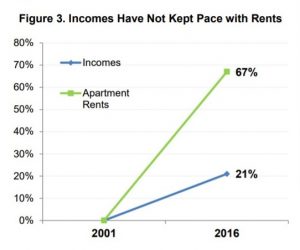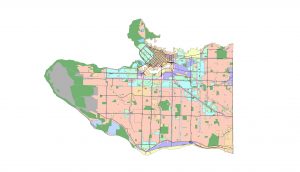This project, undertaken as a course requirement for the Advanced Issues in Geographic Information Systems (GEOB 370) course at UBC in December of 2017, is about the “where” of the current housing crisis in Vancouver. It comes at a time where economic and social indicators for years have been signalling the effects of housing speculation and increased demand has had on the well-being of families, the resilience of communities, and even the ability for employers to secure labour in the city.
Similar crises have emerged in metropolitan regions like the San Francisco Bay Area, where restrictive zoning laws similar to those that exist in Vancouver have exacerbated a housing affordability crisis in which only 58 000 units of new housing have been added for a net increase of 373 000 new jobs in the past 5 years. Given this frame, supply appears to be the main barrier. Rental vacancy rates in Vancouver support this view as well: whereas a healthy rental vacancy rate is around 3%, Vancouver’s was less than 0.5% in 2014.

Above: percent increases in income compared to percent increases in rental costs in Vancouver between 2001 and 2016 (Housing Vancouver Strategy, 2017).
However, it appears that the answer is not as simple as adding supply. In spite of large additions to housing supply in areas surrounding transit stations in Surrey and Coquitlam in the form of condos, these have becoming increasingly less affordable. The issue here may be the lack of diversity in housing supply, and especially the lack of addressing the rental market. Real estate marketer Bob Rennie suggests that diversified housing approaches are required, and that they must go beyond dense condo developments around transit stations and consider the need to sacrifice land in the city devoted to single-family zoning. Which zones should we look at first?

Above: Zoning areas in Vancouver. The peach-coloured zones are all single-family only. (City of Vancouver Open Data Catalogue).
While there are calls like those of Bob Rennie to replace the patterns of speculation of property in single-family zoned neighborhoods with those of balanced development addressing the housing needs of urban residents, we must also consider calls from urban planners like Andy Yan, who suggested that looking at rezoning single-family zoned neighborhoods alone would neglect access to amenities and transportation planning that are important to consider in good land-use planning. Can we intersect the two approaches?
Published this year, the Housing Vancouver Strategy from the City of Vancouver seems to espouse a balanced approach, putting forward the idea of “Right Supply” which focuses on development of rental units and ground-oriented units like rowhomes which both address the needs of Vancouver residents and prevent speculation. The national census data from 2016 was also released this year. The urgency of the crisis, the development and imminent implementation of housing strategies, and the emergence of new social data that could validate approaches and identify areas of priority all point to the timely usefulness of geospatial analyses on housing in the city of Vancouver. In this project, I have conducted one addressing the below research questions:
- What is the relationship between housing supply variations and housing cost variations in the city of Vancouver between 2011 and 2016? What can this tell us about the kind of housing action that need to take place?
- What can census data tell us about where the crisis is worst?
- Where in Vancouver is highest priority given proximity to urban services and work, and gravity of housing shortage?
- Which low-density zoned areas in Vancouver should be re-zoned immediately to accommodate for housing supply?
In the following pages, I outline what geospatial analytical tools I used with ArcGIS to seek to answer these questions, I present the results, and I discuss what was learned from the executed analysis and how geospatial analysis tools could further be applied to refine the “how” and “where” of addressing the housing crisis in Vancouver.